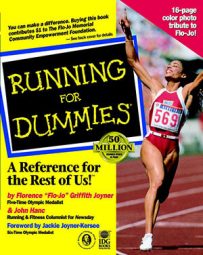Most runners naturally land on the heel and then "roll up" to push off with the ball of the foot or toes. Midfoot strikers push off with the ball of the foot, and those rare forefoot strikers push off with their toes.
Ideally, runners should land lightly on the heel, with the lead leg just slightly bent at the knee (the best method to absorb shock), immediately roll up to the forefoot or toes, and push off powerfully into the next stride.
Here's a form checklist for the legs:
- Land lightly on the heel or midfoot, preferably with your lead leg bent slightly at the knee to help absorb shock. Avoid "reaching" with your lead leg.
- Knee lift should be minimal (except on very steep hills) because too much up-and-down movement results in wasted energy.
- When the leg swings back, you should feel a "flicking" sensation with the heel and ankle. But the flick should not be so much that you are close to kicking yourself in the buttocks.
- Run in a straight line. Make sure that your feet land in parallel paths and do not cross over. Crossover foot strikes are a sure sign of too much twisting and wasted motion.
- After each foot strike, drive into your next stride with a good push off the toes or forefoot.
Avoid overstriding when lengthening your running stride
Novices are often tempted to lengthen their running stride in an attempt to cover more ground. Although increasing your running stride length is one way to run faster, it more often than not results in overstriding. Overstriding, in fact, slows a runner down because it increases impact (and, because of that, injury risk) and takes you longer to get back to your center of gravity and begin the next stride.
You are overstriding if you habitually "reach" with your lead leg in a virtually straight position. When your leg is straight, the first contact with the ground occurs hard on the heel. The result is a lot of shock shimmering up through the lower leg and shins, possibly affecting even your hips and back.
So what's the trick? The way to effectively increase running stride length — without falling into the trap of overstriding — is to improve overall flexibility and muscle strength. It's not a quick fix, requiring a modest (but consistent) stretching program and some strength-enhancing running sessions, such as a weekly hill session.
A good weight-training program, one that addresses the specific needs of runners, can improve overall muscle strength, too. But some renowned coaches, most notably Arthur Lydiard of New Zealand (often called the father of modern distance running methods), believe that hill workouts are the best way to build muscle strength that runners need.
The goal to increase natural running stride length without overstriding requires the following:
- Creating muscles that have a greater range of motion — in effect, increased flexibility.
- Developing stronger muscles capable of pushing off with greater power.
The result should be a slight increase in running stride length that is still within your natural gait. (Overstriding is the enemy of progress!) The gain may be so gradual and small that the average runner may have difficulty noticing. The increased stride length is simply a fringe benefit of your increased flexibility and muscle strength.
Increase your running stride rate
When you start running, increasing stride frequency is easier to achieve than increasing stride length. Some of the increased running stride rate will just come naturally as you get in shape, but you can make major gains by performing high-quality workouts, including even modest speed sessions on the track. Some specific drills, incorporated into your warm-up several times a week, can lay a foundation for an increase in your stride rate.
Some coaches refer to stride frequency or stride rate as leg turnover. The average recreational runner takes about 80 to 85 strides per minute, but most Olympic-class runners can crank out a stride rate of over 180 strides a minute.
An easy drill to add to your running program is "striders" of about 100 yards in length — the length of your basic football field. You should run these briskly, with smooth running form, but not "all out." (For example, if it takes you 15 seconds to run the length of a football field as fast as you can, then run your strider drill closer to 20 seconds per 100 yards.) Try the strider drill two or three times a week, either before or after your easy distance run.
Practice proper mechanics for both your upper and lower body, and include form drills as part of your warm-up. Knowing that your arm action can dictate your running stride length and influence stride rate, you should try to keep focused on your arms in particular.
Another good drill to improve stride frequency is called hot coals. Envision that you are running on a bed of hot coals and you want to "quick step" your way over them. Practice this routine for about 50 yards (perhaps 10 seconds in duration for each hot coal rep) — just long enough so that your feet don't get burned. As with striders, this drill can be part of your warm-up or cool-down.
Running up short flights of stairs, landing on each step, is another drill that can boost your stride frequency. Hit every step as quickly as you can and then walk down for rest. (Try this in small doses — no more than once or twice a week, perhaps for as little as 5 minutes' worth to start — and try alternative workouts, such as hill running, if you experience knee pain.)
If you run five or six days per week, consider taking one day as a "form day." The session shouldn't be a killer in a physical sense, but it can be a day to tune into proper running form and try some running drills.

